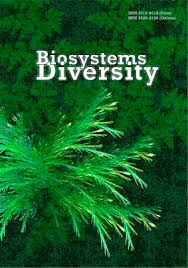Impact of recreational transformation of soil physical properties on micromolluscs in an urban park
Impact of recreational transformation of soil physical properties on micromolluscs in an urban park
Author(s): P. M. Telyuk, V. S. Budakova, N. V. Yorkina, A. K. Umerova, O. M. Kunakh, O. V. ZhukovSubject(s): Agriculture, Sociobiology
Published by: Дніпропетровський національний університет імені Олеся Гончара
Keywords: species response; soil properties; ecological niche; transformation; hemeroby;
Summary/Abstract: The paper assesses the effect of transformation of soil physical properties on the abundance of micromolluscs in the conditions of an urban park. The studies were carried out in Novooleksandrivskiy Park (Melitopol, Ukraine). An experimental polygon was represented by 7 transects with 18 sampling points in each. The interval between the points in the transect, as well as the interval between transects, was 3 meters. The total area of the polygon was 1,134 m2. The tree species growing within the polygon were Quercus robur, Sophora japonica, and Acer campestre. Shrubs were represented by Ulmus laevis, Tilia cordata, Celtis occidentalis, and Morus nigra. The locations of the trees and shrubs were mapped. The crowns of tree and shrub plants formed a dense canopy and a shady light regime. The grass cover was practically absent. The soil mechanical resistance, soil aggregate-size distribution, electrical conductivity of soil, soil moisture and bulk density were measured. We recorded 618 individuals of Vallonia pulchella, 120 individuals of Cochlicopa lubrica, and 58 individuals of Acanthinula aculeata within the surveyed polygon. We extracted three principal components, which could explain 60.9% of the variation in the feature space of the soil properties. The principal component 1 explained 42.0% of the variation of the feature space and depended on the soil penetration resistance throughout the whole profile, aggregate composition, density, electric conductivity and moisture content of soil. This component reflected a tendency for soil penetration resistance and soil density to increase near recreational trails. The principal component 1 was used to indicate the gradient of recreational transformation of the soil. The principal component 2 was able to explain 10.6% of the variation in the feature space. It negatively correlated with the distance from the recreational trail, soil penetration resistance at the depth of 35 cm or more, soil electrical conductivity, and the proportion of aggregates greater than 3 mm in size. This component positively correlated with soil penetration resistance at 0–5 cm depth and the proportion of aggregates less than 0.5 mm in size. This component can be interpreted as a "halo" from the recreational trail, or a gradient of indirect soil transformations adjacent to the zone of intense recreational load. The principal component 3 was able to explain 8.3% of the variation in the feature space. It positively correlated with soil penetration resistance at the depth of 20–40 cm, the proportion of 0.5–7.0 mm aggregates, and soil moisture. It negatively correlated with the proportion of aggregates larger than 7 mm and smaller than 0.25 mm. This component indicated a variation in soil properties that was induced by causes independent of recreational exposure. The extracted gradients of soil properties significantly influenced the abundance of micromollusc populations. The abundance of all species decreased after increase in recreational load. Micromollusc species responded to direct recreational exposure as plateau (C. lubrica) and asymmetric unimodal responses (V. pulchella and A. aculeata).
Journal: Biosystems Diversity
- Issue Year: 29/2021
- Issue No: 2
- Page Range: 78-87
- Page Count: 10
- Language: English

